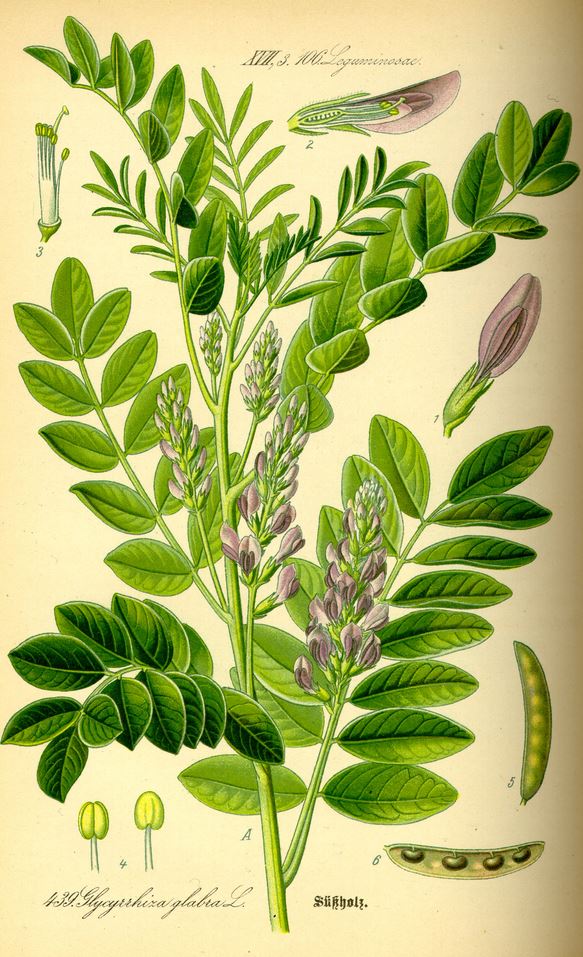Licorice extract. What is it good for?
Since before Theophrastus ( c. 371 – c. 287 BC), licorice root has been used to heal skin lesions. Licorice root is an ingredient of traditional Japanese Kampo and Chinese medicines. But ethnopharmacological use, however ancient, is not proof of effectiveness. Does “modern” science (phytochemistry, biochemistry) support this use of licorice? Yes and no. Licorice root contains many different chemicals, let’s look at them.
 this use of
this use of
Figure: Glycyrrhiza glabra
This is from my Glossary
Natural sweetener, anti-inflammatory, skin brightener.
Licorice root has been used in Europe since prehistoric times, documented since the ancient Greeks, for its anti-inflammatory and antimicrobial activity. Its sweetness comes from glycyrrhizin. The extract, which contains several interesting chemicals, is used topically for its anti-inflammatory properties, and it decreases skin redness and postinflammatory hyperpigmentation.
The isoflavene glabrene and the isoflavane glabridin are phytoestrogens. Glabridrin inhibits the activities of two tyrosinase isozymes without affecting cell proliferation; other chemicals in liquorice also inhibit melanin synthesis. Topical application of glabidrin prevented pigmentation and erythema induced by UV-B.
Did you know that it is possible to die from eating too much licorice (like 2 oz. a day)? The chemical responsible is glycyrrhizin, which is converted in the body into glycyrrhetinic acid and interferes with the conversion of cortisol, causing a drop in potassium followed by heart arrhythmia.
More than 400 chemicals have been isolated from Glycyrrhiza species, and this abundance is not necessarily an advantage if you want to use the total extract. In fact, some chemicals in licorice have antagonistic effects on each other. The solution? Purify the chemicals that have the effect you want. But, if you are planning to use the total root extract, go slowly and make sure you like the effects of the extract you chose.
By structure
The triterpenoid saponins (glycyrrhizin, glycyrrhizic acid), which are the major constituents of licorice, are responsible for the sweet taste.
The isoflavones include glabridin, hispaglabridin A, and 30‐hydroxy‐4‐O‐methylglabridin
The main phenols include liquiritin, isoliquiritin, plus coumarins including licoumarin and glabrocoumarone A and B.
By activity
Antioxidant: isoflavones, e.g. glabridin, hispaglabridin A, and 30‐hydroxy‐4‐O‐methylglabridin
Anti-inflammatory: glycyrrhizin
Antiviral: triterpenoids glycyrrhizin and 18β‐glycyrrhetinic acid
Estrogenic: 18β‐glycyrrhetinic acid, glycyrrhizin (triterpenoid, cortisone-like) and glabridin
References
Fiore C, Eisenhut M, Ragazzi E, Zanchin G, Armanini D. A history of the therapeutic use of liquorice in Europe. J Ethnopharmacol. 2005;99(3):317-324. doi:10.1016/j.jep.2005.04.015
Hwang, Jung-Hee; Lee, Byung Mu. (2007) Inhibitory effects of plant extracts on tyrosinase, L-DOPA oxidation, and melanin synthesis. J. Toxicology and Environmental Health, Part A, 70, 393-407. doi: 10.1080/10937400600882871.
Kim, Hyoung Ja; Seo, Seon Hee; Lee, Byeong-gon; Lee, Yong Sup (2005) Identification of tyrosinase inhibitors from Glycyrrhiza uralensis. Planta Medica, 71: 785-787. doi: 10.1055/s-2005-871232.
Mamedov NA, Egamberdieva D. Phytochemical Constituents and Pharmacological Effects of Licorice: A Review. Plant and Human Health, Volume 3. 2019;1-21. Published 2019 Feb 12. doi:10.1007/978-3-030-04408-4_1
Pastorino G, Cornara L, Soares S, Rodrigues F, Oliveira MBPP. Liquorice (Glycyrrhiza glabra): A phytochemical and pharmacological review. Phytother Res. 2018;32(12):2323-2339. doi:10.1002/ptr.6178
Saeedi, M., Morteza‐Semnani, K., & Ghoreishi, M. (2003). The treatment of atopic dermatitis with licorice gel. J Dermatolog Treatment, 14: 153–7.
Tamir, S.; Eizenberg, M.; Somjen, D.; Izrael, S.; Vaya, J. (2001). Estrogen-like activity of glabrene and other constituents isolated from licorice root. J. Steroid Biochemistry Molecular Biology. 78: 291–298. doi:10.1016/S0960-0760(01)00093-0.
Yokota T, Nishio, H., Kubota, Y., & Mizoguchi, M. (1998). The inhibitory effect of glabridin from licorice extracts on melanogenesis and inflammation. Pigment Cell Research, 11, 355–361. doi:10.1111/j.1600-0749.1998.tb00494.x
